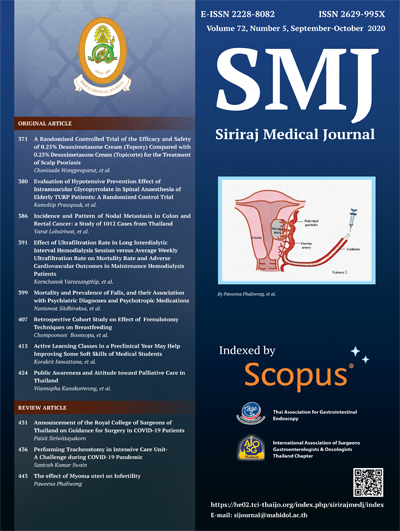Active Learning Classes in a Preclinical Year May Help Improving Some Soft Skills of Medical Students
DOI:
https://doi.org/10.33192/Smj.2020.56Keywords:
Active learning, small group discussion, medical curriculum, preclinical teaching, soft skillsAbstract
Objective: Active learning methods are an effective way to improve essential soft skills, such as critical thinking and social skills, and so medical educators frequently implement active learning approaches as a means to improve the soft skills of medical students. This study reports an improvement in the soft skills of medical students after the implementation of an active learning curriculum.
Methods: More active learning activities were implemented in 2016 in the 3rd year medical class, involving 330 students. Overall, the number of hours devoted to active learning classes was increased from 340 hours (38.2%) in 2015 to 481 hours (59.98%) in 2016. To evaluate whether this led to any improvements in the soft skills of medical students, students undertaking the 3rd year course in the 2015 and 2016 academic years were asked to complete questionnaires to evaluate themselves (self-evaluation as well as four other students in their same study group (peer-evaluation) at the end of the academic year. The questionnaire responses from the 2015 and the 2016 groups were compared.
Results: Most students believed there was no improvement in most of the evaluated soft skills during the year. However, students in the 2016 class showed improvements in eleven outcomes in the peer-evaluation: presentation, information, technology, creativity, communication, leadership, life planning, adaptability, self-sufficiency, courtesy, and punctuality (p < 0.05). The differences were not due to the students’ different background skills as the initial scores of most outcomes were identical between the two student groups (p > 0.05).
Conclusion: Even without a proper design for teaching soft skills, active learning classes in a preclinical year of the medical curriculum may help improve some of the essential soft skills that medical practitioners need and, therefore, should be implemented in the medical curriculum.
References
2. Häkkinen P, Järvelä S, Makitalo-Siegl K, Ahonen A, Näykki P, Valtonen T. Preparing teacher-students for twenty-first-century learning practices (PREP 21): a framework for enhancing collaborative problem-solving and strategic learning skills. Teach Teach 2017;23:25-41.
3. Dede C. Comparing Frameworks for “21st Century Skills”. In: Bellanca J, Brandt R, editors. 21st century skills. Bloomington, IN: Solution Tree Press; 2009.p.51-76.
4. Charlton BG. Lectures are such an effective teaching method because they exploit evolved human psychology to improve learning. Med Hypotheses 2006;67:1261-5.
5. Cantillon P. ABC of learning and teaching in medicine - Teaching large groups. Bmj-Brit Med J 2003;326:437-40.
6. Lujan HL, DiCarlo SE. Too much teaching, not enough learning: what is the solution? Adv Physiol Educ 2006;30:17-22.
7. Felder RM, Brent R. Active learning: An introduction. ASQ Higher Education Brief 2009;2:1-5.
8. Azer SA, Hasanato R, Al-Nassar S, Somily A, AlSaadi MM. Introducing integrated laboratory classes in a PBL curriculum: impact on student's learning and satisfaction. BMC Med Educ 2013;13:71.
9. Freeman S, Eddy SL, McDonough M, Smith MK, Okoroafor N, Jordt H, et al. Active learning increases student performance in science, engineering, and mathematics. Proc Natl Acad Sci U S A 2014;111:8410-5.
10. Zhang S, Xu JC, Wang HW, Zhang D, Zhang QC, Zou LG. Effects of problem-based learning in Chinese radiology education: A systematic review and meta-analysis. Medicine 2018;97.
11. Zhang A. Peer Assessment of Soft Skills and Hard Skills. Journal of Information Technology Education: Research 2012;11:115-68.
12. Cimatti B. Definition, Development, Assessment of Soft Skills and Their Role for the Quality of Organizations and Enterprises. Int J Qual Res 2016;10:97-129.
13. Imwattana K, Kiratisin P, Techasintana P, Ngamskulrungroj P. An impact on medical student knowledge outcomes after replacing peer lectures with small group discussions. MedEdPublish 2018.
14. Medical Competency Assessment Criteria for National License 2012: The Medical Council of Thailand; 2012 [Available from: http://www.tmc.or.th/download/medical2555.pdf.
15. Parmelee D, Michaelsen LK, Cook S, Hudes PD. Team-based learning: A practical guide: AMEE Guide No. 65. Med Teach 2012;34:E275-E87.
16. Abeysekera L, Dawson P. Motivation and cognitive load in the flipped classroom: definition, rationale and a call for research. High Educ Res Dev 2015;34:1-14.
17. Wilson JI. Twenty-first century learning for teachers: helping educators bring new skills into the classroom. New Dir Youth Dev 2006;2006:149-54.
18. Mays KA, Branch-Mays GL. A Systematic Review of the Use of Self-Assessment in Preclinical and Clinical Dental Education. J Dent Educ 2016;80:902-13.
19. Avsar UZ, Cansever Z, Acemoglu H, Avsar U, Ithan AS, Cayir Y. Self-Assessment through Videotaping Compared with Peer and Trainer Feedback. Jcpsp-J Coll Physici 2015;25:41-5.
Downloads
Published
How to Cite
Issue
Section
License
Authors who publish with this journal agree to the following conditions:
Copyright Transfer
In submitting a manuscript, the authors acknowledge that the work will become the copyrighted property of Siriraj Medical Journal upon publication.
License
Articles are licensed under a Creative Commons Attribution-NonCommercial-NoDerivatives 4.0 International License (CC BY-NC-ND 4.0). This license allows for the sharing of the work for non-commercial purposes with proper attribution to the authors and the journal. However, it does not permit modifications or the creation of derivative works.
Sharing and Access
Authors are encouraged to share their article on their personal or institutional websites and through other non-commercial platforms. Doing so can increase readership and citations.














